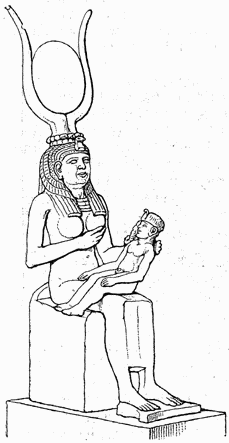This is an old revision of this page, as edited by Formeruser-83 (talk | contribs) at 04:16, 15 March 2004. The present address (URL) is a permanent link to this revision, which may differ significantly from the current revision.
Revision as of 04:16, 15 March 2004 by Formeruser-83 (talk | contribs)(diff) ← Previous revision | Latest revision (diff) | Newer revision → (diff) |
Isis (Greek version, Egyptian is Aset) is the goddess of motherhood and fertility in ancient Egypt. She is a life-death-rebirth deity (see Legend of Osiris and Isis), as well as one of the Ennead. Later, she acquired the goddess Sopdet.
Originally, she was a goddess of royalty (her hieroglyph includes the word for "throne"). Later still, during the period of Greek dominance, she was the patron goddess of sailors.
She was a close companion of Arensnuphis.
Isis was the daughter of Nuit, goddess of the sky, and Seb, god of earth. She married with Osiris, her brother and the father of her son Horus. Osiris was murdered by Seth but she reassembled his body (leading to her associated with the underworld and the funerary cult) and impregnated herself with his body and gave birth to Horus in Khemnis, a swamp. In addition to Horus, Isis was the mother of Min (alternatively, they were lovers).
Together with her sister Nephthys they can be seen on the sides of coffins in human form, their wings outstreched protecting the dead. The sisters also had magical powers.
Isis helped her husband, killed by Seth, to come back to live and take over the rule in the land of the dead.
Isis is often symbolised by a cow, or also a cow's head or horns (illustrating a connection with Hathor). In art, she was depicted with her son, Horus, a crown and a vulture, and sometimes as a kite flying above Osiris' body.
Alternatively, Isis was identified as the scorpion goddess Serq or Selk.
Isis nursing HorusThe cult of Isis rose to great prominence in the Hellenistic world throughout the last centuries BCE up until it was eventually banned by the Christians in the sixth century. Despite the Isis mystery cult's growing popularity, there is evidence to suggest that the Isis mysteries were not altogether welcomed by the ruling classes in Rome. Her rites were considered by the princeps Augustus to be of a "pornographic" nature and capable of destroying the Roman moral fibre. It is not surprising therefore that part of Augustus' programme for reconstruction after the fall of the Roman Republic was an attempt to infuse new life into the old gods of Rome. Tacitus writes that after Julius Caesar's assassination, a temple in honour of Isis had been decreed in a moment of weakness; Augustus suspended this, and tried to turn Romans back to the Roman gods who were closely associated with the state. Eventually, the Roman emperor Gaius abandoned the Augustan wariness towards Oriental cults, and it was in his reign that the Isiac festival was established in Rome. According to Josephus, Gaius himself donned female garb and took part in the mysteries he instituted, and Isis acquired in the Hellenistic age a "new rank as a leading goddess of the Mediterranean world."
Roman perspectives on cult were syncretic, seeing in a new deity merely local aspects of a familiar one. For many Romans, Egyptian Isis was an aspect of Phrygian Cybele, whose orgiastic rites were long naturalized at Rome. In the Golden Ass (1st Century CE) Apuleius' goddess Isis is identified with the Phrygian Cybele:
- "Behold, Lucius, I have arrived. Thy weeping and prayers have moved me to succour thee. I am she that is the natural mother of all things, the Mistress and Governess of all the Elements, the initial Progenitrix of all things, the Chief of powers divine, Queen of Heaven, the First of the Gods celestial, the light of the Goddesses. At my will, the planets of the air, the wholesome winds of the Seas, and the silences of hell are disposed; my name, my divinity is adored throughout all the world in various manners, in various customs and in many names, for the Phrygians call me the Mother of the Gods...' (The Golden Ass)
Among these attributes of Roman Isis, 'Queen of Heaven' is outstanding for its long and continuous history.
Some scholars argue that aspects of Isis worship have influenced the practices of some Christians in regards to the Virgin Mary.
There has recently been a revival of Isis worship among neo-pagans and feminists who are attracted by the matriarchal notions of goddess worship.
External Links
Modern worship
Ancient worship
- [http://www.touregypt.net/ISIS.HTM Egypt:Gods - Isis
